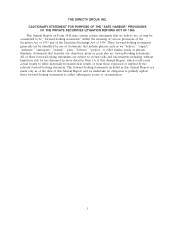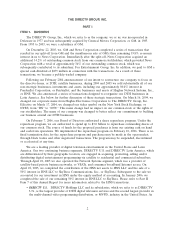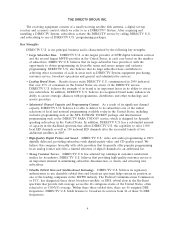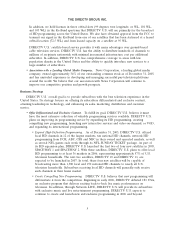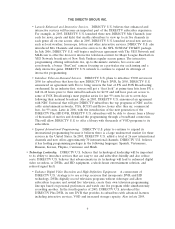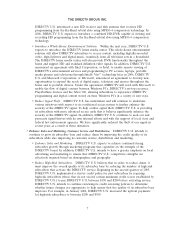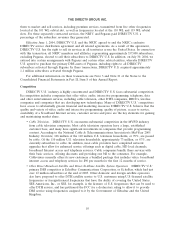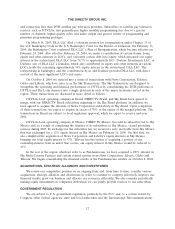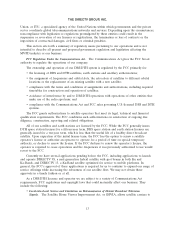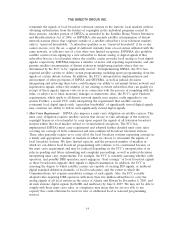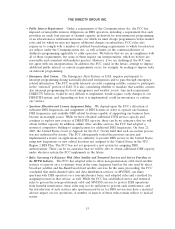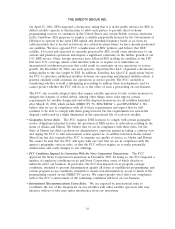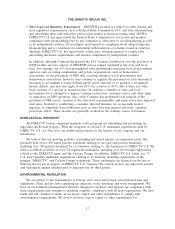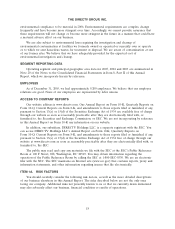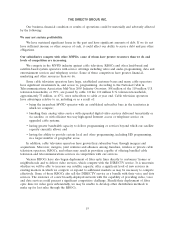DIRECTV 2005 Annual Report Download - page 23
Download and view the complete annual report
Please find page 23 of the 2005 DIRECTV annual report below. You can navigate through the pages in the report by either clicking on the pages listed below, or by using the keyword search tool below to find specific information within the annual report.THE DIRECTV GROUP, INC.
them to market and sell services, including premium services, transmitted from five other frequencies
located at the 101 WL orbital slot, as well as frequencies located at the 110 WL and 119 WL orbital
slots. For these separately contracted services, the NRTC and Pegasus paid DIRECTV U.S. a
percentage of the subscriber revenues they generated.
Effective June 1, 2004, DIRECTV U.S. and the NRTC agreed to end the NRTC’s exclusive
DIRECTV service distribution agreement and all related agreements. As a result of this agreement,
DIRECTV U.S. has the right to sell its services in all territories across the United States. In connection
with this transaction, all NRTC members and affiliates, representing approximately 357,000 subscribers,
excluding Pegasus, elected to sell their subscribers to DIRECTV U.S. In addition, on July 30, 2004, we
entered into certain arrangements with Pegasus and certain other related entities, whereby DIRECTV
U.S. agreed to purchase the primary DBS assets of Pegasus, including rights to all DIRECTV
subscribers activated through Pegasus. In these transactions, DIRECTV U.S. acquired approximately
1.1 million subscribers activated through Pegasus.
For additional information on these transactions see Note 3 and Note 21 of the Notes to the
Consolidated Financial Statements in Part II, Item 8 of this Annual Report.
Competition
DIRECTV U.S.’ industry is highly concentrated and DIRECTV U.S. faces substantial competition.
Its competition includes companies that offer video, audio, interactive programming, telephony, data
and other entertainment services, including cable television, other DTH companies, RBOCs, wireless
companies and companies that are developing new technologies. Many of DIRECTV U.S.’ competitors
have access to substantially greater financial and marketing resources. DIRECTV U.S. believes that the
quality and variety of video, audio and interactive programming, quality of picture, access to service,
availability of a broadband Internet service, customer service and price are the key elements for gaining
and maintaining market share.
•Cable Television. DIRECTV U.S. encounters substantial competition in the MVPD industry
from cable television companies. Most cable television operators have a large, established
customer base, and many have significant investments in companies that provide programming
content. According to the National Cable & Telecommunications Association’s Mid-Year 2005
Industry Overview, 108 million of the 110 million U.S. television households, or 99%, are passed
by cable. Of the 110 million U.S. television households, approximately 73 million, or 67%, are
currently subscribers to cable. In addition, most cable providers have completed network
upgrades that allow for enhanced service offerings such as digital cable, HD local channels,
broadband Internet access and telephony services. Cable companies bundle these services with
their basic services, offering discounts and providing one bill to the consumer. For example,
Cablevision currently offers its new customers a bundled package that includes video, broadband
internet access and telephony services for $90 per month for the first 12 months of service.
•Other Direct Broadcast Satellite and Direct-To-Home Satellite System Operators. DIRECTV U.S.’
primary DBS competitor is EchoStar Communications Corporation, or EchoStar, which had just
over 12 million subscribers at the end of 2005. Other domestic and foreign satellite operators
also have proposed to offer DTH satellite service to U.S. customers using U.S.-licensed satellite
frequencies or foreign-licensed frequencies that have the ability of covering the United States.
SES Americom, Inc., or SES, for example, is the licensee of U.S. frequencies that can be used to
offer DTH service, and has petitioned the FCC for a declaratory ruling to allow it to provide
DBS service using frequencies assigned to it by the Government of Gibraltar and the United
Kingdom.
10



